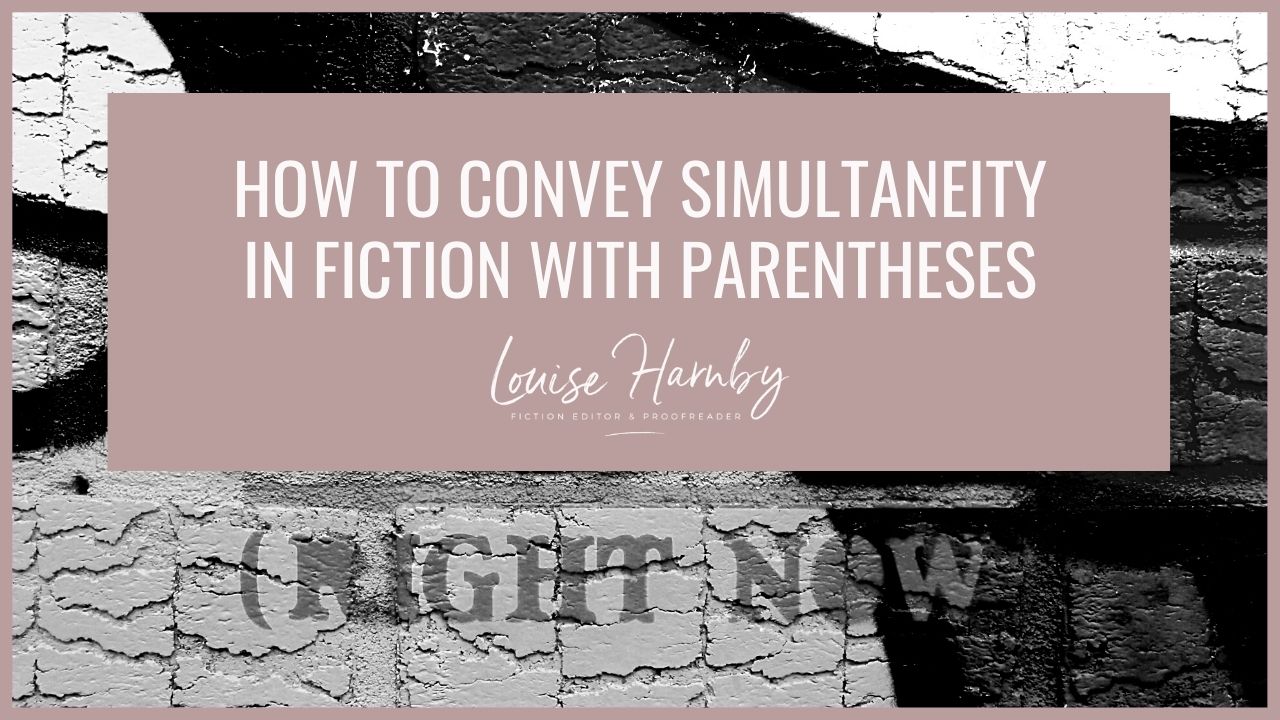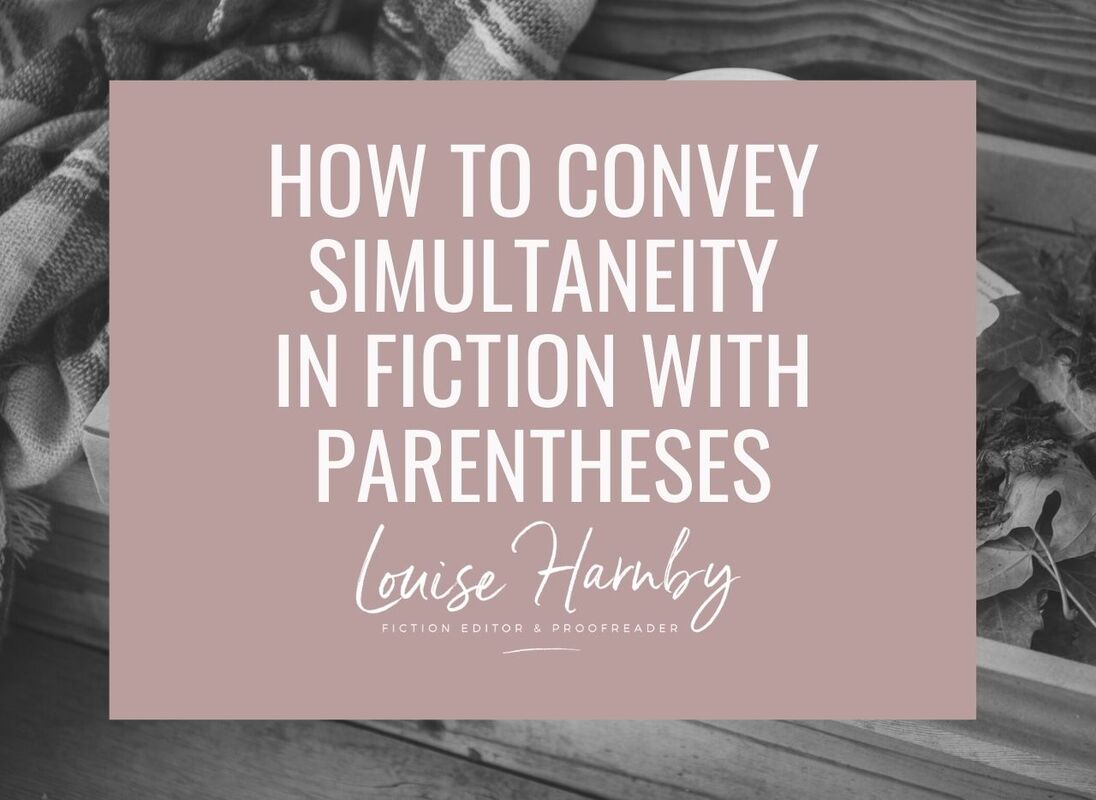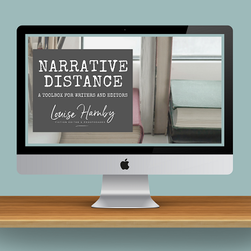|
Parentheses (or round brackets) can help fiction authors evoke a sense of simultaneity in their viewpoint character’s experience – one that challenges a more conventional linear narrative. Here’s how it works.
|
|
Parentheses
|
Tell me about parentheses (round brackets) and how they work.
|
|
Commas
|
Tell me about parentheses, round brackets, and how they work.
|
|
Spaced en dashes
|
Tell me about parentheses – round brackets – and how they work.
|
|
Closed-up em dashes
|
Tell me about parentheses—round brackets—and how they work.
|
Parentheses as convention breakers in fiction
This might be because they’re large and therefore visible marks – ones that demand a reader’s attention. That they’re interruptive could be a good reason to avoid them, though it could equally be the very reason why you want to use them.
The key to using any punctuation mark effectively is to understand its purpose and consider how the reader will interpret it. And so just because the use of parentheses is infrequent enough in fiction to make it unconventional isn’t a reason to ban them from prose.
Parentheses as satirical and viewpoint-switch markers
- For satirical purposes – an external narrator wants to poke fun at a focus character’s behaviour, thoughts or dialogue.
- For viewpoint purposes – the narrative is written from a viewpoint character’s perspective and therefore limited to their experience, but an external narrator wishes briefly to interrupt.
If you’d like to explore my analysis of these two uses, read How to use round brackets (parentheses) in fiction writing.
Scroll through the comments on that post and you’ll see a fantastic question raised by a reader that got me thinking about parentheses again.
The question an author posed
‘Louise, I'm writing a short story in which I have inserted a couple of parenthetical phrases (I don't even know what to call them) which separate one part of a sentence from another. I've seen Stephen King do this and it fascinated me. The character (narrator) is reflecting on a dream she has just awoken from. What do you think of this style, and what is it called?’
I replied admitting that I didn’t know quite what this is called in terms of literary style but that she’d got me thinking, and helped me consider a third function of parentheses that I hadn’t interrogated before: simultaneity.
Here’s her example. It’s from a short story tentatively titled ‘The Woman at the Window’.
(the bombs bursting in air)
bombs that were dropping by the hundreds from a fiery sky.
There are a couple of interesting things going on in Ellen’s example – not just the parenthetical phrase but also the placement of it. It takes its own line, which makes it stand out even more.
Why parentheses can convey simultaneity
‘I wanted to shake the reader up a bit by writing it that way,’ she told me.
And she succeeded. Parentheses do stand out. So does the separate line. But my reading of her work led me to consider another effect she’d created, albeit unwittingly – simultaneity.
How readers process sentences in a linear fashion
This is linear description. We absorb the story in the order the phrases are presented to us – first the dreaming, then the waking-up on a night just before Labor Day, then the terrified screaming, then seeing the exploding missiles, then the glare of the rockets, and finally the flaming sky.
But actually, that’s not how Ellen wrote it. Here’s the unedited version:
(and the rockets' red glare)
and the sky alight with flames.
The rocket-glare phrase is now bracketed and takes its own line. And I think this changes that linearity subtly. It’s as if the glare of the rockets is experienced at the very same moment that the missiles are exploding. It’s another layer of experience that sits behind the explosions.
That’s how we often experience traumatic events in reality. Our brains work so fast that we process multiple pieces of information and feel multiple emotions all at once. The difficulty comes in expressing that in linear text.
In Ellen’s example, the parentheses act as a signal of this simultaneity of experience, and show rather than tell an onslaught of emotional, auditory and visual information.
Showing sensory assault through simultaneity
(the bombs bursting in air)
bombs that were dropping by the hundreds from a fiery sky.
The way the parenthetical phrase punctuates the prose makes me feel uncomfortable. It jars me visually. And that’s why I love it. It shows rather than tells the assault on the senses that I can imagine a person would experience if they were in an environment where missiles were exploding and falling around them.
The character awakes. She’s likely still shaken from the dream, and trying to process what she experienced. And so she narrates what she saw, which pared down is this:
But as she's thinking about this, the bursting bombs is there too, behind the more expository narration, right at the same time. And it’s the bracketed line that shows this.
An alternative might have been:
In that revised version, 'as' tells the simultaneity. It's told prose. Instead, Ellen as author, has shown us with the parentheses, and it's far more dramatic.
And so we might consider parenthetical statements such as this as devices that help authors create layers of simultaneous experience that are warranted when there’s sensory assault in play.
Showing conflict through simultaneity
Here’s an example that I have written more conventionally, using italic and a tag to convey a thought.
Say no, she thought. You don’t have time.
Yes yes yes yes, she typed, because it would be a crap ton of fun and the alternative was D asking someone else, and that was unthinkable.
This approach encourages the reader to approach the prose in a linear way: First D texts Louise with an idea. Then a thought process takes place. Then Louise responds.
But look what happens when we experiment with parentheses.
(Say no. You don’t have time.)
Yes yes yes yes, she typed, because it would be a crap ton of fun and the alternative was D asking someone else, and that was unthinkable.
Now there’s a signal that two conflicting emotional responses are in play simultaneously. Thinking ‘no’ and typing ‘yes’ are occurring at the same time.
Summing up
However, used purposefully, parentheses can enhance that moment and create a sense of simultaneity of experience – perhaps involving an assault on the senses or competing emotions fighting for primacy in a character’s mind.
There are no rules in fiction. Instead, what writers (and the editors who work with them) must strive for is how best to communicate a character’s emotions, perception and actions in the moment, so that the reader can get under the skin of that experience.
And it might just be that – once in a while – a pair of round brackets helps with that goal.
Other resources you might like
|
She is an Advanced Professional Member of the Chartered Institute of Editing and Proofreading (CIEP), a member of ACES, a Partner Member of The Alliance of Independent Authors (ALLi), and co-hosts The Editing Podcast.
- Get in touch: Louise Harnby | Fiction Editor & Proofreader
- Connect: Twitter at @LouiseHarnby, Facebook and LinkedIn
- Learn: Books and courses
- Discover: Resources for authors and editors
In all these examples, we had to be told what the (rounded brackets) meant, and how/why they were being used. That alone diminishes their effectivness. One thing I noticed in the bombs and rockets bit, we have several weak (was/were) verbs trying to support the inflection of fear and uncertainty. For me, this gums up the prose. With those separated lines, I think the parentheses are all but redundant. I do this often enough that I get squiggle lines in the marging from my editor. Now, it just might be my limited comprehension, but I had the vague feeling I was missing something, so my attention was drawn back to the section, thus diluting most of the intended effect. I think there are more effective ways to express simultanity and substantive emotion - dashes come to mind - as do the... well, pause-worthy... elipses. I think it's important to note, too, the author admitted that their intent was to 'shake the reader up a bit', a fete accompli; however, for me, it took me out of the narrative and turned my focus toward something else.
Leave a Reply.
BLOG ALERTS
TESTIMONIALS
Dare Rogers
'Louise uses her expertise to hone a story until it's razor sharp, while still allowing the author’s voice to remain dominant.'
Jeff Carson
'I wholeheartedly recommend her services ... Just don’t hire her when I need her.'
J B Turner
'Sincere thanks for a beautiful and elegant piece of work. First class.'
Ayshe Gemedzhy
'What makes her stand out and shine is her ability to immerse herself in your story.'
Salt Publishing
'A million thanks – your mark-up is perfect, as always.'
CATEGORIES
All
Around The World
Audio Books
Author Chat
Author Interviews
Author Platform
Author Resources
Blogging
Book Marketing
Books
Branding
Business Tips
Choosing An Editor
Client Talk
Conscious Language
Core Editorial Skills
Crime Writing
Design And Layout
Dialogue
Editing
Editorial Tips
Editorial Tools
Editors On The Blog
Erotica
Fiction
Fiction Editing
Freelancing
Free Stuff
Getting Noticed
Getting Work
Grammar Links
Guest Writers
Indexing
Indie Authors
Lean Writing
Line Craft
Link Of The Week
Macro Chat
Marketing Tips
Money Talk
Mood And Rhythm
More Macros And Add Ins
Networking
Online Courses
PDF Markup
Podcasting
POV
Proofreading
Proofreading Marks
Publishing
Punctuation
Q&A With Louise
Resources
Roundups
Self Editing
Self Publishing Authors
Sentence Editing
Showing And Telling
Software
Stamps
Starting Out
Story Craft
The Editing Podcast
Training
Types Of Editing
Using Word
Website Tips
Work Choices
Working Onscreen
Working Smart
Writer Resources
Writing
Writing Tips
Writing Tools
ARCHIVES
July 2024
June 2024
May 2024
April 2024
March 2024
October 2023
August 2023
July 2023
June 2023
May 2023
April 2023
March 2023
January 2023
December 2022
November 2022
October 2022
September 2022
August 2022
July 2022
June 2022
May 2022
April 2022
March 2022
February 2022
January 2022
December 2021
November 2021
October 2021
September 2021
August 2021
July 2021
June 2021
May 2021
April 2021
March 2021
February 2021
January 2021
December 2020
November 2020
October 2020
September 2020
August 2020
July 2020
June 2020
May 2020
April 2020
March 2020
February 2020
January 2020
December 2019
November 2019
October 2019
September 2019
August 2019
July 2019
June 2019
May 2019
April 2019
March 2019
February 2019
January 2019
December 2018
November 2018
October 2018
September 2018
August 2018
July 2018
June 2018
May 2018
April 2018
March 2018
February 2018
January 2018
December 2017
November 2017
October 2017
September 2017
August 2017
July 2017
June 2017
May 2017
April 2017
March 2017
February 2017
January 2017
December 2016
November 2016
October 2016
September 2016
June 2016
May 2016
April 2016
March 2016
February 2016
January 2016
December 2015
November 2015
October 2015
September 2015
July 2015
June 2015
May 2015
March 2015
February 2015
January 2015
November 2014
October 2014
September 2014
August 2014
July 2014
June 2014
March 2014
January 2014
November 2013
October 2013
September 2013
August 2013
June 2013
February 2013
January 2013
November 2012
October 2012
September 2012
August 2012
July 2012
June 2012
May 2012
April 2012
March 2012
February 2012
January 2012
December 2011
|
|
|


















 RSS Feed
RSS Feed





